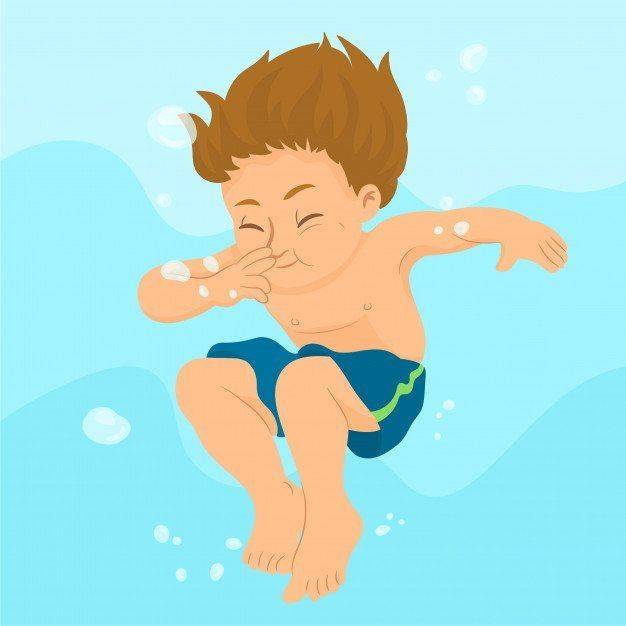
Many people they experience the fear of water (aquaphobia). fear of water. In this article you will find some basic exercises in the water that will help overcome this fear.3
Fear of water - causes
Fear of water can have many different causes:
- It often exists as an instinctive fear related to the fear of drowning.
- It can be caused by the fear of the unknown, of what may be lurking beneath the surface of the water in deep, murky, cloudy or muddy waters.
- It may be related to a bad experience that happened in childhood.
- It can be passed on to a child from parents who are themselves afraid of water.
- It can result from experienced swimming instructors who used inadequate or stressful methods to teach swimming.

Basic exercises - instructions - always with the help of an expert at first, NEVER on your own!
Now let's try to face the fear by doing some basic water exercises.
To get the maximum level of comfort while doing these exercises, it is a good idea to follow the tips below:
- all exercises can and should be done in shallow water. There is no need for the water to reach higher than the chest, so that you can always feel safe.
- do the exercises in a pool with clean water. They are better because you can see what is (or more specifically what is not) in the water and so you will be more relaxed than if you were doing the exercises in opaque water.
- for the same reason, it is recommended to wear swimming goggles while doing the exercises. This way the water won't get into your eyes, and you'll be able to keep them open the whole time, which will help you relax.
- having a support person by your side while you do the exercises can be a big help, especially if he/she is an experienced swimmer who is very comfortable in the water.
- if you can't get the help of a support person, it's a good idea to do the exercises in a pool supervised by a lifeguard who knows what you're trying to achieve and can keep an eye on you.
- ideally, you should do the exercises when the pool is not full, to avoid being stressed by people splashing or throwing water around you
There is no need to rush through the exercises. The primary goal is always to feel comfortable.

Get acclimated to the water
To begin, you will do some exercises to get comfortable in contact with the water, and then enter the water:
- In the shallow end of the pool, sit along the edge of the pool and let your legs dangle in the water, rocking them back and forth. Take your time to enjoy the feeling of the water flowing around your feet.
- Pick up the water with your hands and pour it over your face, as if washing it. This helps to get used to having your face in contact with the water.
- Raise the water with your hands again, hold your breath and then splash the water on your face. As you wear swimming goggles, your eyes are protected, and you can try to keep them open. As you hold your breath and sit upright, you should notice that water cannot enter your nose and mouth. Enjoy the refreshing sensation of water on your face.
- Enter the water slowly, from the steps into the shallow pool area. Make sure the water does not reach above your chest. Walk for some time, staying in the shallow area of the pool. Enjoy the feeling of the water flowing around your body.
Dipping your head in the water
The following exercises will help you gradually submerge your head in the water until you feel comfortable with your head under water. For this exercise, we will stay in shallow water.
- Hold your breath. Slowly bend down to the lips your to be just above the surface of the water. How do you feel; See if you can get comfortable with the water so close to your lips. Then stand up.
- Hold your breath. Slowly bend down (with your mouth closed) and see if you can put your mouth under the water, with the surface of the water between your mouth and nose. Notice that the water cannot enter your mouth.
- After a while, notice that your nose is still above the surface of the water. If the water is calm and there are no waves, try breathing through your nose while still keeping your mouth underwater. Notice that you can breathe through your nose, even if your mouth is under water. Now stand up. Repeat often to be able to breathe comfortably with your nose so close to the surface of the water.
Some advice
Hold your breath. Slowly bend down until your mouth touches the surface of the water and submerge it under the water. Bend down a little more until your nostrils touch the surface of the water. If possible, hold this position for a few seconds, then stand up to breathe.
Now, what you need to know at this point is that some water will get into your ears. But that's okay, because the water can't go any further than the eardrum and will leave the ear once you're out of the water.
Hold your breath. Now slowly bend down and let the water cover your mouth, nose, ears and sink further down to the point where your eyes move below the surface of the water. As you wear swimming goggles, water cannot get into your eyes. Try to hold this position for a few seconds, then stand up again and breathe.
Once you are comfortable with your eyes below the surface of the water and can keep your eyes open, take time to observe this strange underwater world that opens up for you.
Blowing bubbles
Once you are comfortable with your head under water, the next step in overcoming your fear of water is to learn that it is possible to breathe out in water without getting water in your nose and mouth.
The best exercise for this is to learn how to blow bubbles.
1) Breathe while standing in the shallow area of the pool and hold your breath. Then bend down so that your mouth is below the surface of the water, but your nose is still above the surface of the water. Exhale slowly through the mouth, creating bubbles in the water.
You will realize that as long as you exhale, water cannot enter your mouth. The same is true if you hold your breath. Stand up again to breathe.
The human body floats easily
So far, we have practiced some basic exercises to overcome the fear of water and get used to being in the water.
Now we will see that it is, in fact, easy to float on water without much effort.
If you are anxious, you may think that in the water you will sink to the bottom like a stone. But it may surprise you that water actually supports the human body very well. In most cases, people can float effortlessly without using their limbs as long as their lungs are filled with air. fear of water
This is because your body, which is made of 60% water, is less dense than water, provided your lungs are full of air.
You've really come a long way with your fear of water so far. Your coach will now help you with simple exercises to learn to float in different positions.
If you've done these exercises, I hope you've discovered that being in the water doesn't have to be scary, but can be quite enjoyable when you can relax and feel comfortable.

I hope that with time and practice, you will be able to overcome your fear of water. Don't rush, take your time working on these exercises, even if it takes a few weeks or more. Worth! fear of water

No Comments